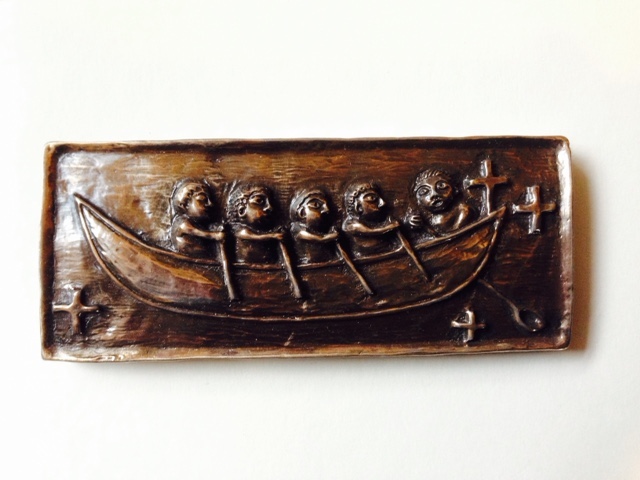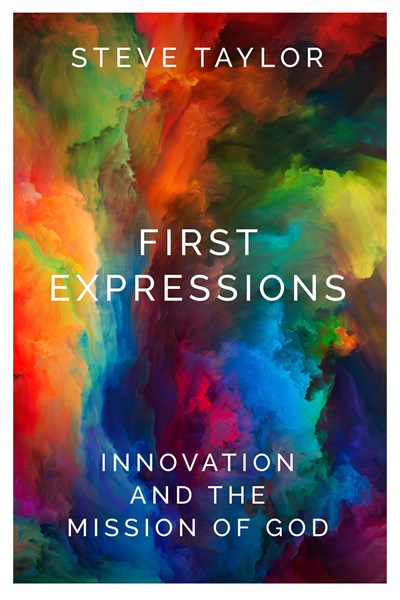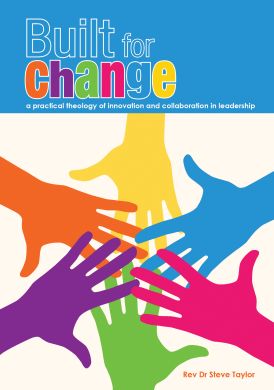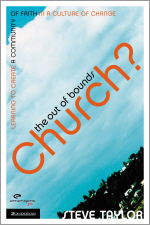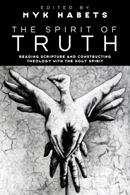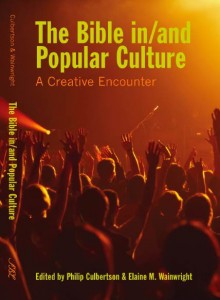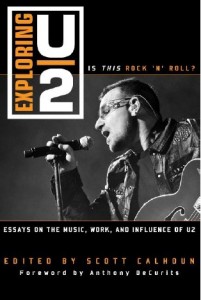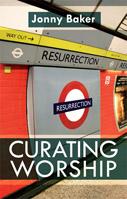Sunday, May 16, 2010
word of mission: a forgotten Uniting church treasure?
Over the weekend I discovered (thanks to Stephen Burns, who was a wonderful breath of fresh air in my attempts to understand the practice of mainline worship) what I think is a forgotten Uniting church treasure. In Uniting in Worship 2, the official book that guides Uniting worship, is a pattern for worship. The pattern is four-fold:
- Gathering – including welcome and prayers of praise and confession
- Word – including Scripture reading, preaching and prayers for others
- Table – communion
- Sending
The final section – Sending – is divided into a song, a benediction and this thing called “Word of mission.” This “Word of mission”, according to the book, could be a verse of Scripture, a sentence or a brief charge to the people.
I’ve never heard this, in all the Uniting services I’ve been part of. I wonder why I’ve not heard it. I wonder if it is just me, or if it’s fallen out of favour in general across the denomination. I wonder if it’s neglect says something about Uniting church life.
But what a gift, a moment when the people of God pause and prepare themselves for service in God’s world. It has all sorts of creative possibilities
– sharing in 2’s
– photos of the community which one is going to
– sounds of the world outside the church walls
– a litany of the places God is calling us to
– summing up the all that has gone before in the service in light of mission
– being recorded/journalled and then reflected on by leaders in terms of what God is saying in mission
Indeed, a forgotten treasure.
Saturday, May 15, 2010
a pentecost journal
Here’s an idea … why not every church start a Pentecost journal. This would be read every year at Pentecost. Then, after a time of silence for reflection, updates to the journal would be invited. People would name how the Spirit has been active among them in the year gone. These would be typed up, and added to the journal.
Which would be read again next year.
This would honour the Spirit as alive today, honour the Spirit as alive in history, appreciate the Spirit as diverse and creative in the life of the community, develop skills of discernment and just be plain interesting.
It is an idea that has some echoes to the Advent journals I initiated at Opawa. It emerged in my Grow and go Mission-shaped community class today. We were talking about innovation (one of the 9 National Church Life Survey indicators of a healthy church) and to make this practical, the class were introduced to a number of ways to practise creative brainstorming. In the process, as groups laughed and talked, a number of random linkages were made …
Wednesday, May 12, 2010
Ascension worship: the footprints of Jesus
I enjoyed how Ascension day chapel worship shaped up today. I always find it hard to put worship experiences into words, but for what it’s worth here are some of the pieces. The Biblical spark was the Ascension and in reflecting on the text I was struck by the idea of Ascension as the departing feet of Jesus. Real feet, now leaving.
That provided a working tactile image, footprints. And then the madly, obvious idea, to have footprints, and to invite people to stand in these footprints of Jesus. This was achieved prior by painting some barefeet, and then walking over 3 metre long strips of frostcloth. (The kids absolutely loved giving me a hand with this part!) When it dried, they looked great. Very simple. Very effective. One set of footprints were in colour.
The other set were in black.
This allowed multiple stations:
- the black footprints; the Ascension as the absence of Jesus and so the invitation to stand on the (dried) footprints and pray for ourselves and for others we know who experience God as absent.
- the colour footprints, reflecting on the impact of the footprints of Jesus, who had walked with and among the disciples. I laid, face down, beside each colour footprints, various cards from the Jesus deck (I got my deck here some years ago and it was great to get a chance to use them). So, if people chose to participate, there was a real sense of mystery about which card they would choose and thus which story of Jesus they might engage with.
The colour had another layer. I had started by offering cut up paint chips from paint charts, and the invitation for people, as they arrived, to choose a colour that symbolised their week. As part of our call to worship we shared our chips with each other. Fun, interactive, but an essential part of gathering ourselves as real people, with real stories – and of course the living “colourful” stories of Jesus continuing today.
Around this was woven the usual frame – praise, confession, Bible readings both Old Testament and New Testament, passing the peace, affirmation of faith, sermon, communion, benediction. For those interested, I’ll place the order of service below.
For me, I had quite profound encounters at both stations. The Jesus deck card I turned up was just bang on the nail in terms of my struggle to follow Jesus at the moment. So bang on the nail it was almost spooky. (more…)
Saturday, May 08, 2010
Ascension day and emerging worship with Paul Kelly
I spent some time in preparation for leading (Wednesday chapel) worship, playing with Ascension Day, which the church affirms, as it says in the Apostles Creed:
I believe in Jesus Christ, his only Son, our Lord …
He ascended into heaven
and is seated at the right hand of the Father.
Tall skinny kiwi engages with Jeremy Begbie concerned that the emerging church doesn’t engage with Ascension Day. Well, Jeremy obviously doesn’t read this emergent/ing blog, like back in 2007 when I noted what Ascension day means for Christian faith. (Get with the internet Jeremy) and when I noted the following points about Ascension Day.
- God in Jesus is present through all time and space.
- A human body now live with God.
- Faith without sight is now the normal way to follow Jesus.
- God’s people are the primary hermeneneutic of the Gospel.
Anyhow, back to my emerging worship, with me making random connections, humming the Paul Kelly song, “Meet me in the middle of the air”, which was played in my recent Sociology for Ministry class. (Here’s a cover, the actual song I was thinking about was Paul at the bushfire concert.
In the midst of all that bushfire pain, Paul sings acapella a song that seems to claim outrageous hope in the world beyond. Was it inappropriate? Pietistic? Or is there more going on in the music and life of Paul Kelly, that lets him slap a form of eschatalogical, Ascension-like hope on the bushfire table?
Is this why Ascension Day is important for the church – in Creed, worship and theology – because it keeps alive a note of outrageous hope? If so, when, how, in the midst of a broken world, to name it? Not sure if such thoughts will be woven into Wednesday worship, but writing them helps me process them.
Friday, April 16, 2010
re-framing the prodigal in regard to fresh expressions and established church
Ben Edson has re-written the parable of the Prodigal son/Waiting Father/Faithful son/absent prodigal daughter (choose your title with care, because each character opens up a different interpretive lens).
There was a mother who had two sons. The youngest one said to his mother, mother thanks for the years that you’ve looked after me, thanks for all that you’ve give me, but I think that you’ve got it wrong. I’m going to take all that I have inherited from you and go off to country foreign to you and experiment.
After being away for sometime the younger son started to recognise that he had been foolish and needed the love and support of the mother. He decided to go home back to the mother. He would say to her: I am sorry that I left you, your resources are so diverse, I miss you and I want to be part of your family.
The first part is here. The conclusion, offering 3 alternative endings
- the institutional church’s slow grinding to death of innovation
- the arrogance of fresh expressions
- an embrace between margin and centre
is here. It’s a wonderful example of re-framing and re-creating, and a fascinating use of Scripture.
Initially I loved it, the creativity, the multiplicity of endings. But now I’m not at all sure. When I have the words to name my unease, I’ll try to complete this post by explaining why … (more…)
Tuesday, April 13, 2010
saying thanks: turning practices into missional life
This is a most excellent example of helping a community give thanks. It is a church wall at Church of the Trinity Uniting, Goodwood. People are being given (paper) flowers and invited to give thanks.
Over weeks the wall is growing, an emerging symphony of colour. Over weeks what people write seems to be deepening. Over the weeks, people are commenting they are finding themselves becoming more and more intentional about looking for reasons to be thankful in their daily lives. Good stuff. (The pastor, very wisely IMHO, is photographing the wall each week, planning to make it into a movie, to play at years end.)
This became an excellent learning moment in our Missional Church Leadership class (3rd gathering of 10). We were looking at ways to listen and I was talking about appreciative inquiry, the simple practice of saying thanks, as a window into where God’s Spirit might be active. And how the simple act of naming ie saying thanks, gives people an opportunity to further participate.
And at that moment, the photo got passed around and we admired the colour and the effective, yet creative way, of helping people worship.
What intrigues me is how this simple, yet intentional, worship practice might actually be part of the church’s ongoing intentional mission life.
For example: Why not take a note of the recurring themes. Then invite all those who gave thanks over a year to a gathering. Share with them the themes. Get people in groups around questions like what surprises you? Then ask them to think about ways the community could further develop this theme ie be yet more thankful. Perhaps they are thankful for family. Get them to brainstorm ideas, ways they could focus their energy on families. Record the findings and ask if any people want to part of giving their dreams legs.
Start a second year with a second wall. See what happens as you gather people intentionally around what they have identified as important and significant.
Such, I would suggest, is the task of missional leadership:
1. Invite people into missional practices
2. Mirror back to people what is emerging as the practices are lived.
3. Gather conversations about next steps: how then shall we live?
4. Record the findings and return to 1.
It was a great class! (Even without the learning that emerged as another student talked about farm gates. But that’s for another post.)
Thursday, April 01, 2010
communion as community storytelling
Craig Mitchell offered what I found a wonderfully helpful communion at chapel here on Wednesday.
Often the words leading into communion are said by the person at the front and run the danger of becoming a potentially lengthy monologue. Instead, on Wednesday, leading into communion, the communion leader asked questions of those gathered. Questions like
Why have we gathered here?
What story shall we live?
Where did this story begin?
Whose story is this?
Why then should we speak of this story?
Tell me what he said and did
Let’s celebrate the way that grace has shaped our lives, I invite you to say aloud a prayer of thanks
What is our prayer on this day?
The responses (scripted) were provided by those gathered. In so doing, the people told of the redemptive story, proclaimed the words of Institution, welcomed the Spirit, joined with the crowd of witnesses.
It felt so much more like the work of the people. It reminded me of the Jewish Passover tradition in which learning happens on a question and answer basis. Thus faith formation is placed within the context of home and food and inter-generational relationships. Doing this in Holy Week added yet another layer, for it was on Maundy Thursday that Jesus gathered his disciples for the last time in a Passover type meal.
So thanks Craig, for offering simultaneously a fresh, yet deeply traditional approach to communion.
Friday, March 19, 2010
u2 chapter accepted for publication
News overnight that my U2 conference paper – Sampling and reframing: the evolving live concert performances of “Bullet the Blue Sky” – has been accepted for publication. Date and publisher still to be clarified, but with over 40 papers being submitted for a book of about 15 chapters, I’m stoked.
It’s also my first foray into the arts and music world outside the church, so the whole process – having the chance to present a paper and now have that accepted for publication, is a pretty big tick in terms of what I do and teach (the paper began life as a casestudy in a lecture in my Living the text in a postmodern context.”
Here is the “abstract”:
“Bullet the Blue Sky” is the fourth track on U2’s 1987 album, The Joshua Tree. The song was originally written as a commentary on a highly particularized context, the involvement of the United States military in Central America during the 1980’s. Over time, this highly particularized political context has changed, yet the song has continued to be performed by U2.
Using commercially available concert footage, this chapter will explore the changes and development in the song’s performance, over a twenty year period, with a particular focus on concerts in Paris (1987), Slane Castle (2001) and Chicago (2005).
Following one song over an extended period allows an exploration of how a band can reframe and re-perform their music as the context and culture shifts. (Hint, hint, what churches are seeking to do every Sunday in relation to Bible and church tradition! Ed)
The theoretical frameworks of narrative mapping and analyzing popular culture using the metaphor of sampling will be employed. Narrative mapping allows complex data to be analyzed in real time, as it unfolds, while sampling involves the collage-like re-appropriating of already existing elements in the pursuit of creativity.
Naming these samples, including song snippets, video and theatrical performances, and how they work in relationship to the audience, demonstrates a complex renegotiation of the meaning of “Bullet the Blue Sky” and shows how “sampling” a song might address new contextual and political issues. The application of installation art theory offers insights into the public negotiation of communal memory and provides another window by which to appreciate U2’s live concert performances. (Hint, hint, creativity in the context of gathered worship! Ed)
Wednesday, March 10, 2010
pass the peace in God’s world as acts of prodigal fathering
I fumbled the benediction in chapel today. Life’s a bit full at the moment, so I was bound to fumble something at some point and life’s like that.
The Biblical text was the prodigal son and around that Jonny Baker and I framed call to worship, an imaginative engagement with the text, some stations to allow reflection, confession, intercession and communion.
I was aware that there was no “passing of the peace” and aware that this has been a feature of various Uniting College chapel service’s I’ve been a part of. I’d been teaching just before chapel, looking at New Testament images of church. Which include the new creation and salt, as an image for a church deeply immersed in the world.
So it seemed to me in light of that impulse, that passing the peace could thus be an act of benediction, an invitation to mission as Christ’s reconciling people, offering the embrace of the father as an act of prodigal fathering.
So I decided in the midst of the service to conclude with a benediction, “Go, Pass the peace, in God’s world.”
So I invited people to face the door. But all that came out was the word “peace.” I waited for more. So did those gathered. I knew I had more to say, but my brain had simply stopped working. And so we all exited, knowing that something had not quite been completed.
Life’s like that sometimes.
So I simply note it here for completeness, for humour and as a theological and liturgical question:
What are the implications of making the passing of the peace the benediction, rather than an act in worship and after confession?
Friday, March 05, 2010
praying the psalm? or the moment?
My Paraclete Psalter: A 4-Week Cycle for Daily Prayer arrived this week. It prays all the Psalms over a 4 week period. This is not a heavy book of Daily prayer, flipping from page to page. This is the Psalms arranged morning, lunch, tea and evening, as an invitation to use the Psalms, stones worth smooth by the centuries (to quote Rowan Williams). It’s gorgeous, just begging to be touched and opened. Leather cover, delicate pages, light and transportable.
The Psalms are arranged according to the time of day, which makes for a lovely resonance.
Until I went swimming.
And then my Psalter suddenly felt a bit sloshy – in a good, yet provoking, way.
The sun was setting into the sea and I just floated, watching this golden orb drop away. It all got pretty spiritual. It even got captured in a prayer: Swimming this evening; Sun dropping gold orbed into summer sea, God of full immersion, Swirl in, on, around me; Your resting child.
Which got me wondering about the place of spiritual disciplines in life. Was this not my “evening Psalm prayer”; the giving of my day, what was done and undone, to God? Wasn’t that Psalm, waiting in my Psalter, crafted out of a moment exactly like this? How do these natural and unexpected moments of our lives align themselves with the “stones worn smooth” of the church’s history? How often is our worship captured in a building and a book, strained through someone else’s words, in a way that alienates us from the moments of life?
Sunday, February 14, 2010
wood fired pizza worship
 I was making pizza on Saturday afternoon. Homemade tomato pesto, mixed with finely cut basil and baby spinach leaves (from the newly planted “only-been-in-the-country-3-weeks-garden” of course!), topped with local sundried tomato and lots of cheese. Very simply, very yummy. (Picture does not represent the reality).
I was making pizza on Saturday afternoon. Homemade tomato pesto, mixed with finely cut basil and baby spinach leaves (from the newly planted “only-been-in-the-country-3-weeks-garden” of course!), topped with local sundried tomato and lots of cheese. Very simply, very yummy. (Picture does not represent the reality).
And I thought again about pizza church. Not just pizza as in, oh, we are funky because we eat pizza after worship. Which would be yummy enough.
But more like that sense of making a pizza out of what’s in the fridge. And how what’s in our fridge is simply a reflection of our lives. So why can’t that be the central image for being a worshipping community?
I mean, what it would be like for church to set up a woodfired pizza outside. Bases supplied. And the invitation for worship to be about bringing toppings from what’s in your fridge.
You could have a thanks pizza and a confession pizza and an intercession pizza.
And as each pizza is served, there’s time for a toast. And those who want can name, either by ingredient or by spoken words, what they might be bringing – their praise and their confession and their intercession. And so the pizzas are the worshipping work of the people, what’s in our lives, brought to community, shaped by the liturgical pattern of traditional worship – praise, confession, prayer.
This might not be a normal way for people to experience church, but it would be easy to run an experiment, try it for a few months, simply by working your way through say the gospel of Luke. Lots of food moments there, and so the preaching/teaching moment would involve serving the 2 fish and 5 loaves pizza, the eucharist pizza, and so on through the Gospel of Luke, using table fellowship as the metaphor. In other words, the Scriptures are embodied in the “Bible pizza”, offered to those who gather.
A simply over the top idea and I returned to the much simpler task, of calling the Taylor tribe for homemade pizza. And together we gave thanks – for a few of our favorite things – weekends and each other and the promise of a new life.
Tuesday, December 22, 2009
kiva loans for Christmas
I’m playing with Kiva loans and Christmas and mission. (More info here).
1. At our Christmas services we often create interaction by asking who’s come the furthest, who’s up the earliest etc, who’s had the most Christmas’s. We often give out a little prize. So why not give out a Kiva gift voucher? It would splendidly capture the spirit of Christmas and would connect local with global mission.
Updated: Church manager said yes. We’ve had financial gifts flowing in all week, for us to give as appropriate. Yee ha.
2. Why not give Kiva as a Christmas gift. Imagine the kids on Christmas afternoon, huddled over the computer, deciding who they’re going to loan to, and letting them align themselves with global mission. Much more Christian use of time than trashing some toy.
3. Use Kiva to kickstart micro-finance in your community. Give out 20 lots of $25 (total $500), to people in your church. A random surprise one Sunday. Some churches ask for money, we give money! After 6 months invite them to a Kiva evening, to share what they gave to and what has happened. Use that energy to ask questions:
- Could we do micro-loans in our community?
- What questions would we need to ask first?
Send people off to do research, and bring a recommendation to your church community. Give out locally, 20 lots of “microfinance.” After 6 months, meet for yet another, but this time local, Kiva evening, to share stories and see what the next step is.
What is Kiva? Glad you asked? Use this video (and below) on Christmas morning, with your kids and at your Kiva evenings.
Monday, December 21, 2009
advent blessings bannering: from process to prayer
A fabric artist, visiting from another city, was just in the auditorium admiring our banners. It’s neat to have people in the church for “creativity’s sake”. All four banners are now up, and looking fine.
(poor shot, but it gives you some idea of the height, scope and colours.) The process is pretty team-like
- Lynne did the design on publisher
- emailed it to Lawence, who as an engineer works for a firm that has a photocopier that prints to A0
- who gives the black and white banners to Carolyn and Jan, who add pastels
- who gives them to Pete, who hangs them.
Cost. $16! Plus creative time. The response has been simply excellent and it’s given some real shape and energy to our Advent.
My spiritual director challenged me to weave the four Advent blessings into the lighting of the Advent candles. So here’s version 1.
In Numbers, Old
God faces
failed Aaron, and wrestling Jacob
shines grace
ALL: Old to New, in Jesus, come
In Corinthians, New
as Spirit waters prayerless,
hard edged prisons, now new,
graced spaces
ALL: Old to New, in Jesus, come
In Jude, future
face forward
new Adam builds blushing bride
ALL: Old to New, in Jesus, come
In Luke, Mary giggles – yes
Elizabeth embraces – out of bounds no
as Jesus moves heaven to earth
ALL: Old to New, in Jesus, come
Advent blessings – four; we await the face of God in Christ
ALL: Old to New, in Jesus, we say welcome
So there we are. I suspect a totally unique approach to Advent!
Wednesday, December 02, 2009
an advent blessing: some great u2 theology
Following posts on Advent creative prayers stations and Advent creative spirituality2go home prayer activities, here’s an Advent blessing I’m pondering.
It’s not mine. It’s from Bono. At the end of City of Blinding lights, live streamed on the internet from Los Angeles, he ad libbed a new ending:
Blessings, not just for the ones who kneel
Luckily, luckily
We don’t believe in luck.
Grace abounds.
Grace abounds.
Seems to me to be great theology and particularly suitable for Advent. It was so easy for Israel to think they were the centre of God’s world. And so easy for the church and Christians to think today they are the centre of God’s world. But as we are reminded in Psalm 67: 1-2
May God be gracious to us and bless us and make his face shine upon us,
that your ways may be known on earth,
your salvation among all nations.
God’s face shines most fully both on Jesus, and in Jesus. A message not just for the lucky ones, but for all upon whom God’s grace abounds.
